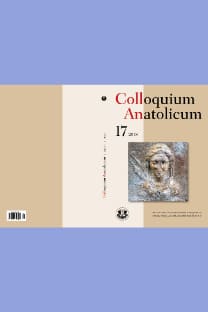Antik çağ'da strigilisin ecza amaçlı kullanımı: Veriler ve kanıt
farmakoloji
Pharmaceutical purpose of the strigilis in antiquity data and evidence
pharmacology,
___
Aetios Amidenos 1899 BIBLIA IATRIKA EKKAIDEKA / Die Augenheilkunde des Aetius aus Amida, (çev. J. Hirschberg), Leipzig.Celsus (Aulus Cornelius)1953 De Medicina / On Medicine, (çev. W. G. Spencer), Londra.
Galenos 1821-1833 PERI FUSIKON DUNAMEWN / Claudii Galeni Opera Omnia, (çev. C. G. Kühn), Leipzig.
Marcellus Empiricus 1968 Marcellus, De Medicamentis, (çev.}. Kollesch - D. Nickel), Berlin.
Plinius (Gaius, Secundus) 1956-1966 Naturalis Historia / Natural History, (çev. H. Rackham), Londra.
Paulus Aegineta 1844-1847 Epitomae Medicae / The Seven Books of Paulus Aegineta, (çev. F.Adams), Londra.
Scribonius Largus 1983 Compositiones / Scribonii Largi Compositiones, (çev. S. Sconocchia),Leipzig.
Orta Çağ Kaynakları
Abûl Kasım Al Zahravi 1861 La Chirurgie DAlbucasis, (çev. L. Leclerc), Paris.
Şerefeddin bin Ali 1992 Cerrahiyyetul Hâniyye, (çev. İ. Uzel - K. Süveren), Ankara.
Modern Kaynaklar
Baykan, D.2002 "Allianoi Tıp Âletleri", Bilim ve Ütopya Eylül: 76.
2005 "Allianoi'da Bulunan Pişmiş Toprak Ecza Kapları", III. Uluslararası Seramik, Cam, Emaye, Sır ve Boya Semineri Bildiriler Kitabı, Eskişehir: 447-452.
2009a Allianoi Tıp Âletleri, İstanbul Üniversitesi, Sosyal Bilimler Enstitüsü, Klasik Arkeoloji Anabilim Dalı (Yayınlanmamış Doktora Tezi), İstanbul.
2009b "Gladyatör Hastanesi: Allianoi", Atlas 201: 48-50.
Bliquez, L.J.2003 "Roman Surgical Spoon-probes and their Ancient Names ([ir]Ar|, jiriXurrpu;, specillum)", JRA 16: 322-330.
Jackson, R.1999Roma împaratorluğu'nda Doktorlar ve Hastalıklar, (çev. Ş. Mumcu), İstanbul.
Kancheva-Ruseva, T. - K. Velkov - V. Ignatov 1996 Prouchvaniya na Nadgrobni Mogili v Novozagorsko, N. Koichev ve M.Kanchev Memoriam, Bulgaristan: 17-70.
Kessyakova, E. - N, Kirova 2005"Brickwork Double Grave From The Roman Age From The Village of Scutare, Plovdiv District", Universitatis Serdicensis Supplementum IV, Stephanos Archaeologicos in honorem Professoris Ludmili Getov, Sofya: 406-419.
Künzl, E. 1983 Medizinische Instrumente aus Sepulkralfunden der römischen Kaiserzeit, Bonn.
1992„Spatantike und byzantinische medizinische Instrumente", From Epidaurus to Salerno. Symposium held at the European University Centre for Cultural Heritage, (Haz. A. Krug), PACT 34: 201-244.
Michaelides, D.1984"A Roman Surgeon's Tomb from Nea Paphos Part I", Report of the Department of Antiquities of Cyprus: 315-332.
Milne, S.J.1976 Surgical Instruments in Greek and Roman Times, Chicago.
Uzel,İ.2000 Anadolu 'da Bulunan Antik Tıp Aletleri, Ankara.
- ISSN: 1303-8486
- Yayın Aralığı: 1
- Başlangıç: 2002
- Yayıncı: Türk Eskiçağ Bilimleri Enst.
Ein hethitisches Hieroglyphensiegel im Mardin Museum
RAFET ÇAVUŞOĞLU, Bilcan GÖKÇE, Kenan IŞIK
Oluz Höyük Kazısı Üçüncü Dönem 2009 Çalışmaları Değerlendirmeler ve Sonuçlar
Antik Çağ’da Strigilisin Ecza lı Kullanımı Veriler ve Kanıt
Gyges'in Sadyattes'i tahttan indirme hikayesi: Yeni bir gözden geçirme
Mardin Müzesi’nden Hiyeroglifli Bir Hitit Mührü
Oluz Höyük kazısı üçüncü dönem (2009) çalışmaları: Değerlendirmeler ve sonuçlar
